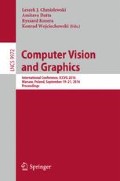Abstract
The transition problem is one of the important problems of animation. The Penners easing functions solve this successfully. There are some well known and widely used approximations of these functions where Bézier curves have been used. However, the transition functions, obtained by such approximation differ substantially from the original. We proposed new form of approximation in the paper. Two class of easing functions are discussed. In first simple approximation allows obtaining sufficient effects. In the second the easing function is divided into two symmetric parts where the approximation is done. For every approximation the root mean square error (RMSE) has been determined and the animated transition using new solution is analyzed. The new approximation allows obtaining better RMSE as well as better visual effects in animation.
Access this chapter
Tax calculation will be finalised at checkout
Purchases are for personal use only
References
Parent, R.: Computer Animation, 3rd edn. Morgan Kaufmann, Burlington (2012)
Penner, R.: Motion, tweening, and easing. In: Programming Macromedia Flash MX, chap. 7, pp. 191–240. McGraw-Hill/OsborneMedia (2002). http://www.robertpenner.com/easing/penner_chapter7_tweening.pdf. Accessed 10 Mar 2016
Robert Penner’s Easing Functions. http://robertpenner.com/easing/. Accessed 10 Mar 2016
Owen, M., Willis, P.: Modelling and interpolating cartoon characters. In: Proceedings of the Computer Animation 1994, Geneva, 25–28 May 1994, pp. 148–155. http://ieeexplore.ieee.org/iel2/987/7718/00323996.pdf. Accessed 10 Mar 2016
Melikhov, K., Tian, F., Seah, H.S., Chen, Q., Qiu, J.: Frame skeleton based auto-inbetweening in computer assisted cel animation. In: Proceedings of the 2004 International Conference on Cyberworlds (CW 2004), 18–20 November 2004, Tokyo, Japan, pp. 216–223 (2004)
Sakchaicharoenkul, T.: MCFI-based animation tweening algorithm for 2D parametric motion flow/optical flow. Mach. Graph. Vis. Int. J. 15(1), 29–49 (2006)
van der Spuy, R.: Tweening. In: van der Spuy, R. (ed.) Advanced Game Design with HTML5 and JavaScript, chap. 10, pp. 369–406. Apress/Springer, New York (2015)
Peters, K.: Tween Engines. In: Peters, K. (ed.) Advanced ActionScript 3.0 Animation, chap. 10. Apress/Springer, New York (2009)
EasingCurve Class. In: Qt Documentation. http://doc.qt.io/qt-4.8/qeasingcurve.html. Accessed 10 Mar 2016
jQuery user interface, Easing. https://jqueryui.com/easing/. Accessed 10 Mar 2016
Easing Functions. In: .NET Framework v4 Documentation, https://msdn.microsoft.com/en-us/library/ee308751%28v=vs.100%29.aspx. Accessed 10 Mar 2016
Tweener (ActionScript) at GoogleCode. https://code.google.com/archive/p/tweener/. Accessed 10 Mar 2016
The secret of tweening: when and when not to. Broder Jakobs Flash. http://www.broderjakob.se/2007/09/07/the-secret-of-tweening-using-it-when-you-need-it/. Accessed 10 Mar 2016
Apt, D.: An Introduction to Tweening with ActionScript 3.0. (2009). http://code.tutsplus.com/tutorials/an-introduction-to-tweening-with-actionscript-30--active-2022. Accessed 10 Mar 2016
Smith, J., Smith, C., Gerantabee, F.: How to Create a Motion Tween in Adobe Flash CS6. http://www.dummies.com/how-to/content/how-to-create-a-motion-tween-in-adobe-flash-cs6.html. Accessed 10 Mar 2016
Cascading Style Sheets (CSS). The Official Definition, W3C Working Group Note, 13 October 2015. https://www.w3.org/TR/CSS/#css. Accessed 10 Mar 2016
Lie, H.W.: Cascading HTML Style Sheets a Proposal. https://www.w3.org/People/howcome/p/cascade.html. Accessed 10 Mar 2016
Ceaser CSS Easing Animation Tool. https://matthewlein.com/ceaser/. Accessed 10 Mar 2016
Tween Class. http://www.createjs.com/docs/tweenjs/classes/Tween.html. Accessed 10 Mar 2016
AHEasing. A library of easing functions for C, C++ and Objective-C. https://github.com/warrenm/AHEasing. Accessed 10 Mar 2016
Easing Equation by Robert Penner. http://gizma.com/easing/. Accessed 10 Mar 2016
Tween-functions. Robert Penner’s easing functions, slightly modified. https://www.npmjs.com/package/tween-functions. Accessed 10 Mar 2016
Author information
Authors and Affiliations
Corresponding author
Editor information
Editors and Affiliations
A Formulas of the Penner’s Easing Functions
A Formulas of the Penner’s Easing Functions



Rights and permissions
Copyright information
© 2016 Springer International Publishing AG
About this paper
Cite this paper
Izdebski, Ł., Sawicki, D. (2016). Easing Functions in the New Form Based on Bézier Curves. In: Chmielewski, L., Datta, A., Kozera, R., Wojciechowski, K. (eds) Computer Vision and Graphics. ICCVG 2016. Lecture Notes in Computer Science(), vol 9972. Springer, Cham. https://doi.org/10.1007/978-3-319-46418-3_4
Download citation
DOI: https://doi.org/10.1007/978-3-319-46418-3_4
Published:
Publisher Name: Springer, Cham
Print ISBN: 978-3-319-46417-6
Online ISBN: 978-3-319-46418-3
eBook Packages: Computer ScienceComputer Science (R0)

